Regulation of the NMDA receptor complex and trafficking by activity-dependent phosphorylation of the NR2B subunit PDZ ligand
- PMID: 15537897
- PMCID: PMC6730169
- DOI: 10.1523/JNEUROSCI.0546-04.2004
Regulation of the NMDA receptor complex and trafficking by activity-dependent phosphorylation of the NR2B subunit PDZ ligand
Abstract
Interactions between NMDA receptors (NMDARs) and the PDZ [postsynaptic density-95 (PSD-95)/Discs large/zona occludens-1] domains of PSD-95/SAP90 (synapse-associated protein with a molecular weight of 90 kDa) family proteins play important roles in the synaptic targeting and signaling of NMDARs. However, little is known about the mechanisms that regulate these PDZ domain-mediated interactions. Here we show that casein kinase II (CK2) phosphorylates the serine residue (Ser1480) within the C-terminal PDZ ligand (IESDV) of the NR2B subunit of NMDAR in vitro and in vivo. Phosphorylation of Ser1480 disrupts the interaction of NR2B with the PDZ domains of PSD-95 and SAP102 and decreases surface NR2B expression in neurons. Interestingly, activity of the NMDAR and Ca2+/calmodulin-dependent protein kinase II regulates CK2 phosphorylation of Ser1480. Furthermore, CK2 colocalizes with NR1 and PSD-95 at synaptic sites. These results indicate that activity-dependent CK2 phosphorylation of the NR2B PDZ ligand regulates the interaction of NMDAR with PSD-95/SAP90 family proteins as well as surface NMDAR expression and may be a critical mechanism for modulating excitatory synaptic function and plasticity.
Figures
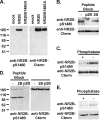
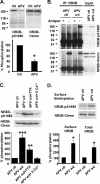
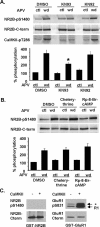
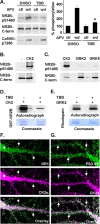

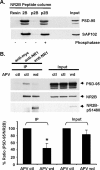
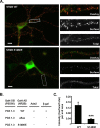

Similar articles
-
Casein kinase 2 regulates the NR2 subunit composition of synaptic NMDA receptors.Neuron. 2010 Sep 23;67(6):984-96. doi: 10.1016/j.neuron.2010.08.011. Neuron. 2010. PMID: 20869595 Free PMC article.
-
alpha-Isoform of calcium-calmodulin-dependent protein kinase II and postsynaptic density protein 95 differentially regulate synaptic expression of NR2A- and NR2B-containing N-methyl-d-aspartate receptors in hippocampus.Neuroscience. 2008 Jan 2;151(1):43-55. doi: 10.1016/j.neuroscience.2007.09.075. Epub 2007 Oct 12. Neuroscience. 2008. PMID: 18082335 Free PMC article.
-
Hippocampal synaptic plasticity involves competition between Ca2+/calmodulin-dependent protein kinase II and postsynaptic density 95 for binding to the NR2A subunit of the NMDA receptor.J Neurosci. 2001 Mar 1;21(5):1501-9. doi: 10.1523/JNEUROSCI.21-05-01501.2001. J Neurosci. 2001. PMID: 11222640 Free PMC article.
-
Protein-protein interactions at the NMDA receptor complex: From synaptic retention to synaptonuclear protein messengers.Neuropharmacology. 2021 Jun 1;190:108551. doi: 10.1016/j.neuropharm.2021.108551. Epub 2021 Apr 2. Neuropharmacology. 2021. PMID: 33819458 Review.
-
PSD-95-like membrane associated guanylate kinases (PSD-MAGUKs) and synaptic plasticity.Curr Opin Neurobiol. 2011 Apr;21(2):306-12. doi: 10.1016/j.conb.2011.03.001. Epub 2011 Mar 28. Curr Opin Neurobiol. 2011. PMID: 21450454 Free PMC article. Review.
Cited by
-
Selective regulation of NR2B by protein phosphatase-1 for the control of the NMDA receptor in neuroprotection.PLoS One. 2012;7(3):e34047. doi: 10.1371/journal.pone.0034047. Epub 2012 Mar 30. PLoS One. 2012. PMID: 22479519 Free PMC article.
-
Importance of the GluN2B carboxy-terminal domain for enhancement of social memories.Learn Mem. 2015 Jul 15;22(8):401-10. doi: 10.1101/lm.038521.115. Print 2015 Aug. Learn Mem. 2015. PMID: 26179233 Free PMC article.
-
The synaptic localization of NR2B-containing NMDA receptors is controlled by interactions with PDZ proteins and AP-2.Neuron. 2005 Sep 15;47(6):845-57. doi: 10.1016/j.neuron.2005.08.016. Neuron. 2005. PMID: 16157279 Free PMC article.
-
Glutamate receptor abnormalities in schizophrenia: implications for innovative treatments.Biomol Ther (Seoul). 2012 Jan;20(1):1-18. doi: 10.4062/biomolther.2012.20.1.001. Biomol Ther (Seoul). 2012. PMID: 24116269 Free PMC article. Review.
-
Protein Kinase C-Mediated Phosphorylation and α2δ-1 Interdependently Regulate NMDA Receptor Trafficking and Activity.J Neurosci. 2021 Jul 28;41(30):6415-6429. doi: 10.1523/JNEUROSCI.0757-21.2021. Epub 2021 Jun 17. J Neurosci. 2021. PMID: 34252035 Free PMC article.
References
-
- Aoki C, Fujisawa S, Mahadomrongkul V, Shah PJ, Nader K, Erisir A (2003) NMDA receptor blockade in intact adult cortex increases trafficking of NR2A subunits into spines, postsynaptic densities, and axon terminals. Brain Res 963: 139-149. - PubMed
-
- Barria A, Malinow R (2002) Subunit-specific NMDA receptor trafficking to synapses. Neuron 35: 345-353. - PubMed
-
- Bayer KU, De Koninck P, Leonard AS, Hell JW, Schulman H (2001) Interaction with the NMDA receptor locks CaMKII in an active conformation. Nature 411: 801-805. - PubMed
-
- Beattie EC, Carroll RC, Yu X, Morishita W, Yasuda H, von Zastrow M, Malenka RC (2000) Regulation of AMPA receptor endocytosis by a signaling mechanism shared with LTD. Nat Neurosci 3: 1291-1300. - PubMed
-
- Blanquet PR (1998) Neurotrophin-induced activation of casein kinase 2 in rat hippocampal slices. Neuroscience 86: 739-749. - PubMed
Publication types
MeSH terms
Substances
LinkOut - more resources
Full Text Sources
Other Literature Sources
Molecular Biology Databases
Miscellaneous
